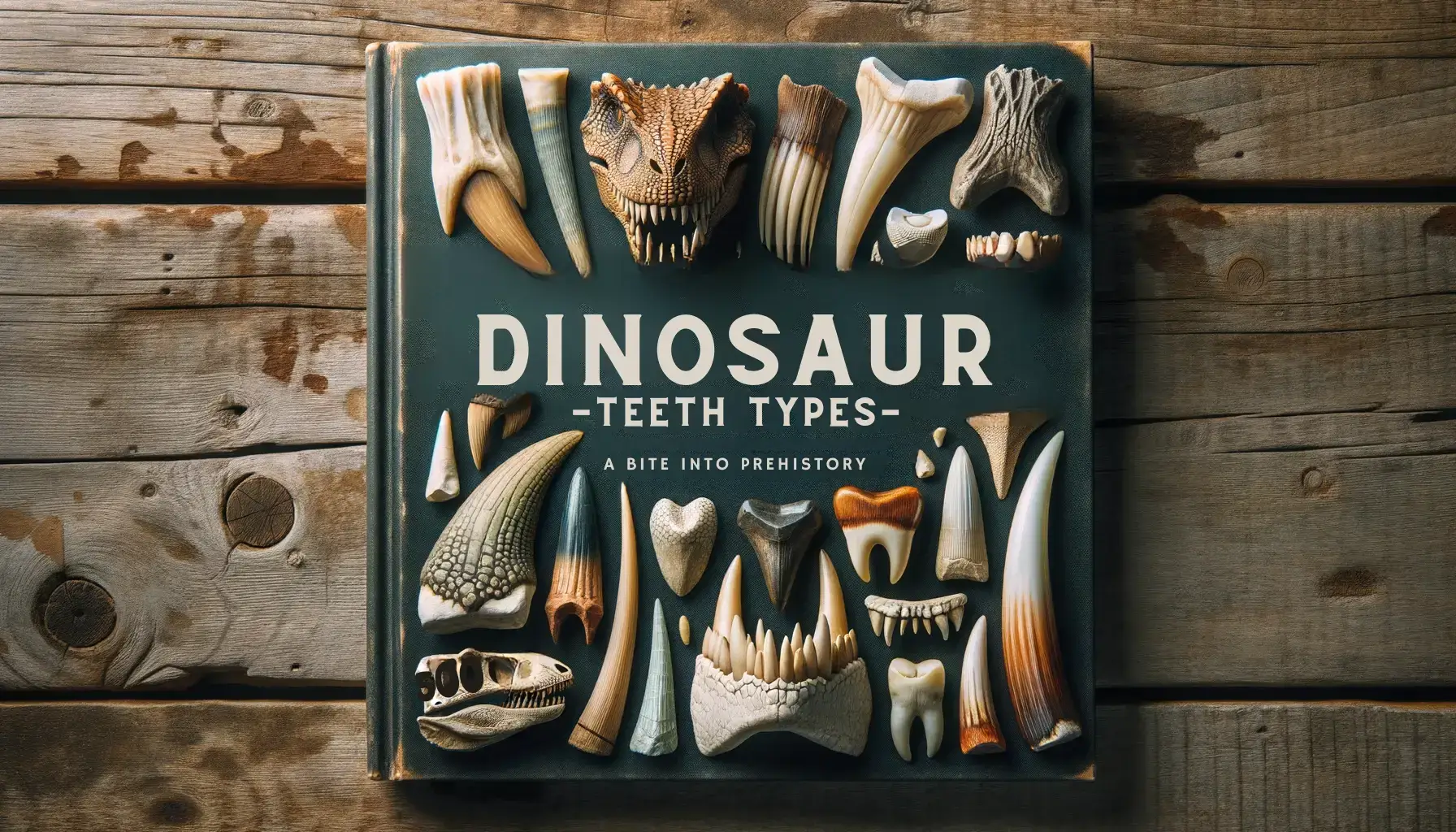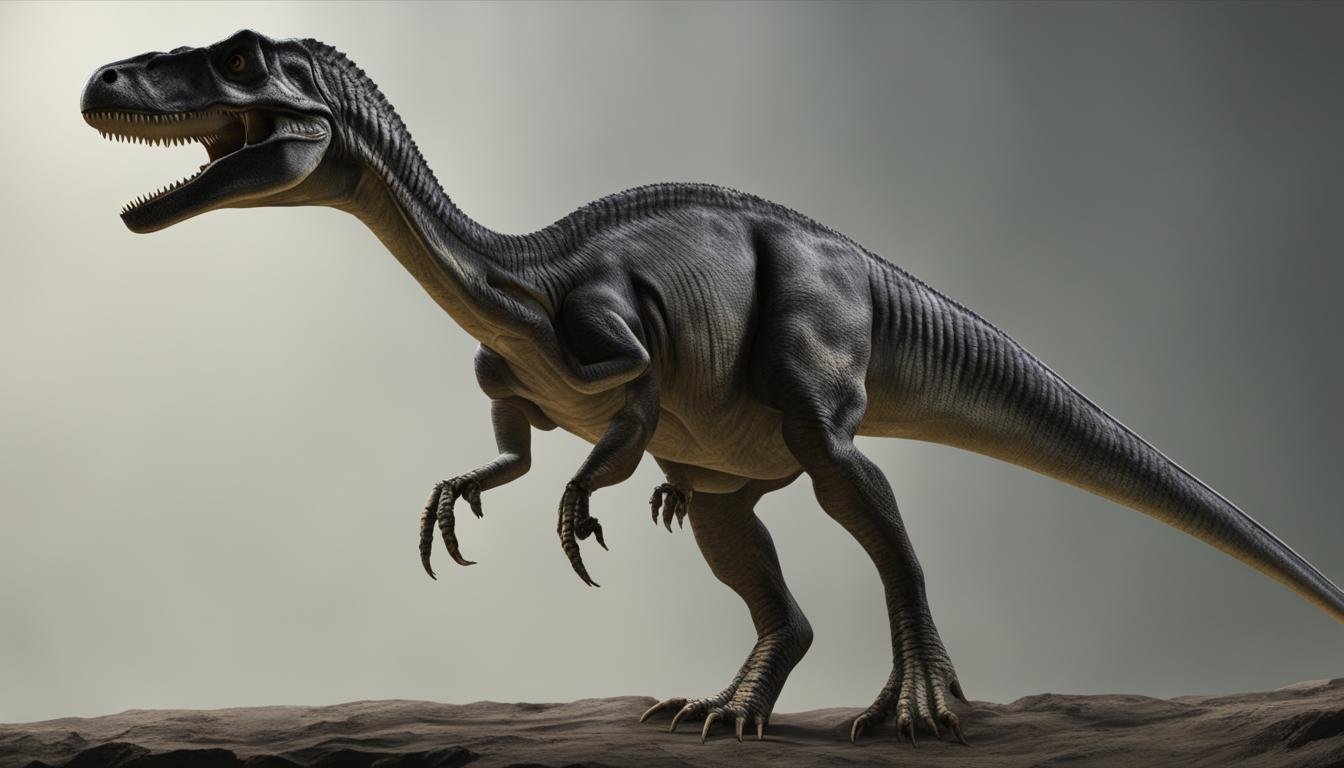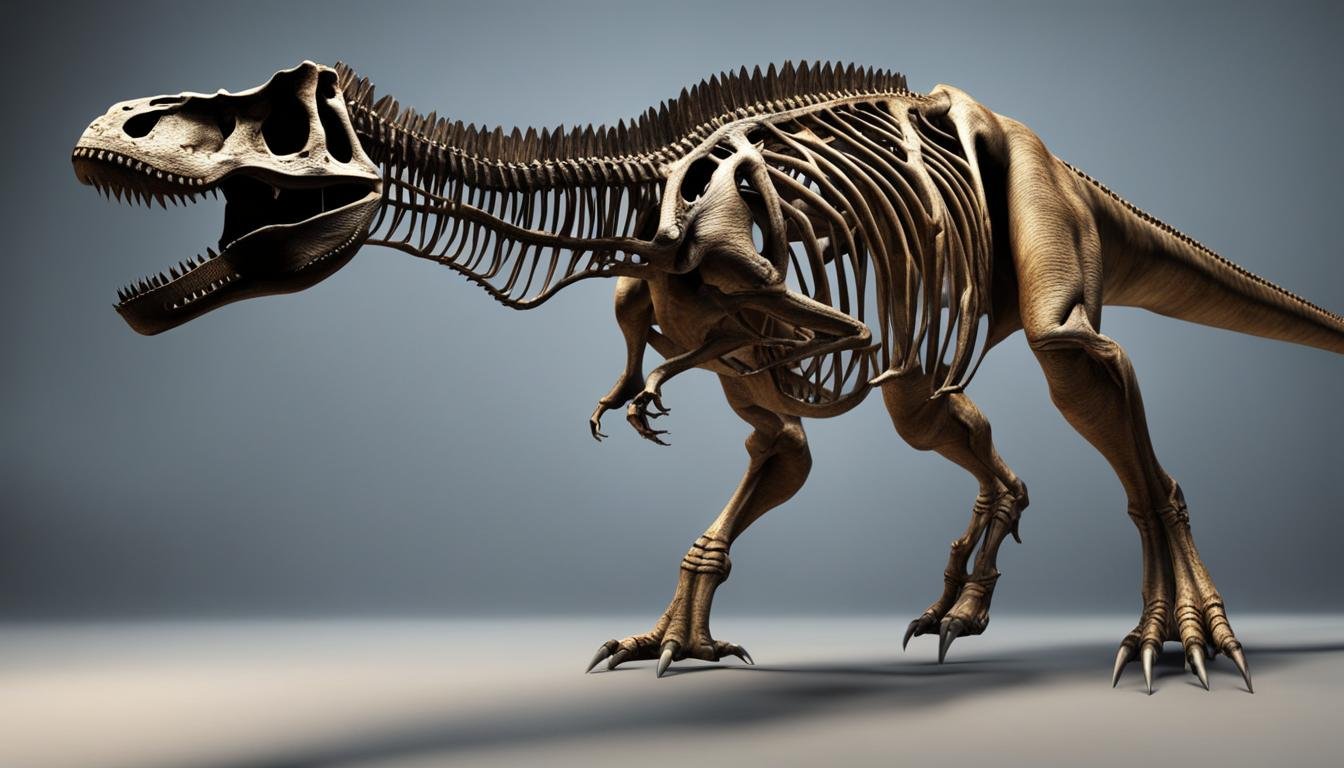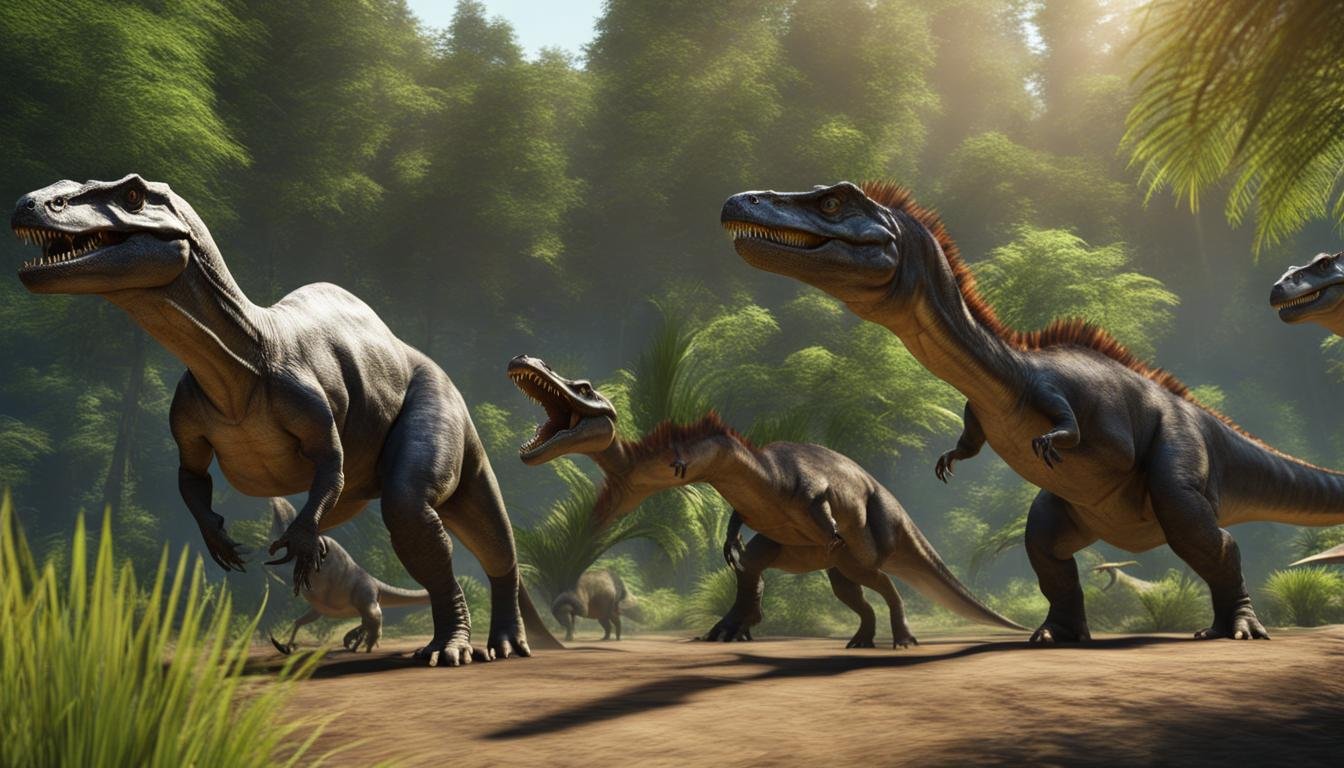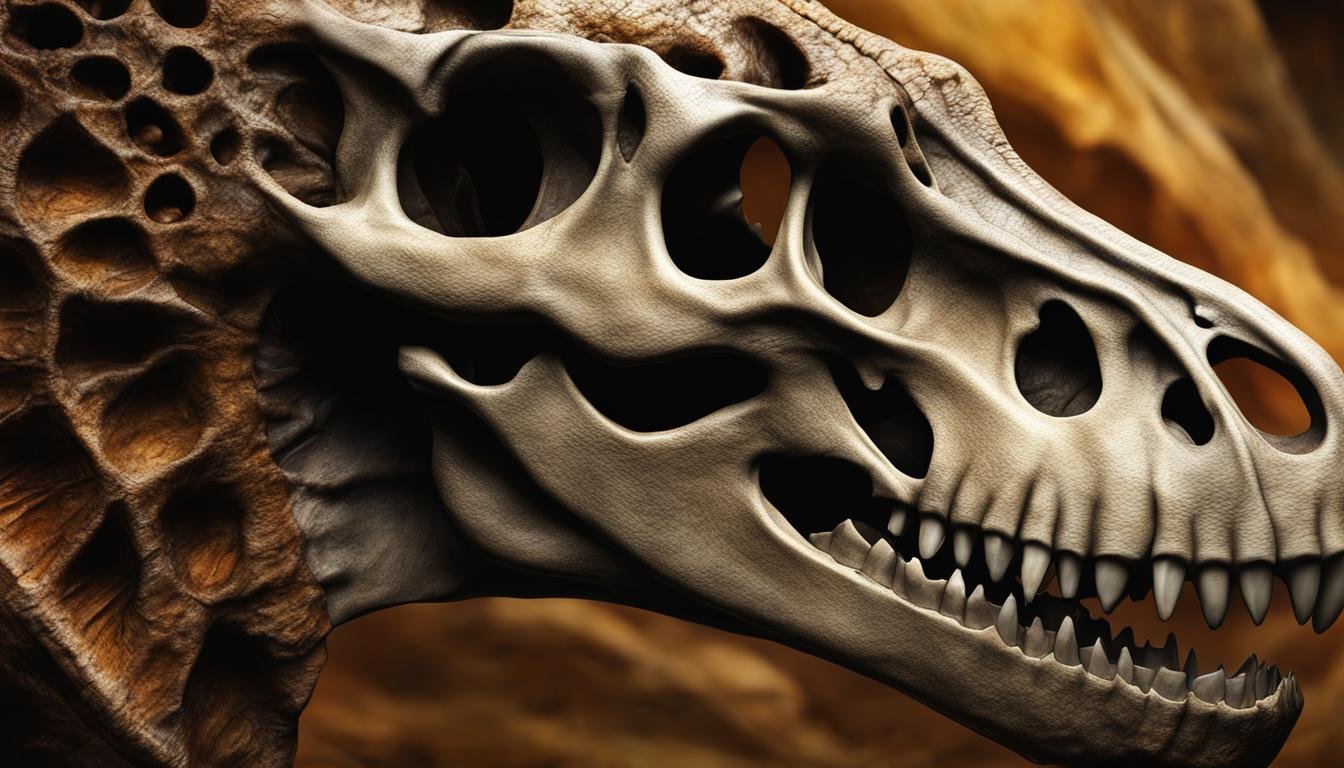Did you know that the length of a dinosaur’s tooth could give a sneak peek into its prehistoric lifestyle? Imagine a Tyrannosaurus Rex, with its bone-crushing teeth, or the peaceful Triceratops, grinding plant matter with its flat molars. The incredible variety in dinosaur teeth shapes and sizes not only unveils the eating habits of these astonishing creatures but also uncloaks a fascinating past where every bite marked a tale of survival. Let’s embark on a captivating journey to explore the varied dinosaur teeth types, and how they are a window into the prehistoric era.

What are Dinosaur Teeth?
Dinosaur teeth are the fossilized dental remains of dinosaurs that roamed the Earth millions of years ago. Unlike modern-day reptiles, dinosaurs had teeth that were specialized in function, akin to mammals today. These ancient choppers range from the ferocious canines of predatory dinosaurs to the flat, grinding teeth of herbivores.
Components of Dinosaur Teeth
Dinosaur teeth, much like ours, comprised several layers:
- Enamel: The outermost layer, which is the hardest and provides a shield against wear and tear.
- Dentin: Situated beneath the enamel, dentin is somewhat similar in composition to our teeth’s dentin but often shows remarkable structural adaptations to a dinosaur’s diet.
- Pulp: The innermost section housing nerves and blood vessels.
Each component had a role to play in the functionality and durability of the teeth, tailored to the dinosaur’s dietary needs.
| Component | Description |
|---|---|
| Enamel | Outermost layer, hardest, shield against wear and tear |
| Dentin | Beneath enamel, similar to our dentin, dietary adaptations |
| Pulp | Innermost, houses nerves and blood vessels |
Function of Dinosaur Teeth
The primary function of dinosaur teeth was to aid in feeding. However, the form and function of these teeth were as varied as the dinosaurs themselves:
- Cutting and Tearing: Carnivorous dinosaurs like the Tyrannosaurus Rex had sharp, serrated teeth for cutting through flesh.
- Grinding and Chewing: Herbivorous dinosaurs such as Triceratops had broader, flat teeth ideal for grinding plants.
- Piercing: Some dinosaurs like the Velociraptors had teeth designed for piercing through the flesh of their prey.
| Function | Description | Examples |
|---|---|---|
| Cutting and Tearing | Sharp, serrated teeth for cutting through flesh | Tyrannosaurus Rex |
| Grinding and Chewing | Broader, flat teeth for grinding plants | Triceratops |
| Piercing | Teeth designed for piercing through flesh of prey | Velociraptors |
| Tools of Survival | Beyond feeding, ward off threats or process high-fiber plants | Predators and Herbivores alike |
These dental distinctions were critical for the survival of different dinosaur species, each adapting to the diet available in their habitat, showcasing a fascinating interplay of ecological roles within the prehistoric ecosystem.
The function of dinosaur teeth also extended beyond mere feeding; they were tools of survival. Predators showcased their menacing teeth to ward off threats and competitors, while herbivores used theirs to reach and process high-fiber plant matter, ensuring a nutritionally adequate diet in a competitive environment.
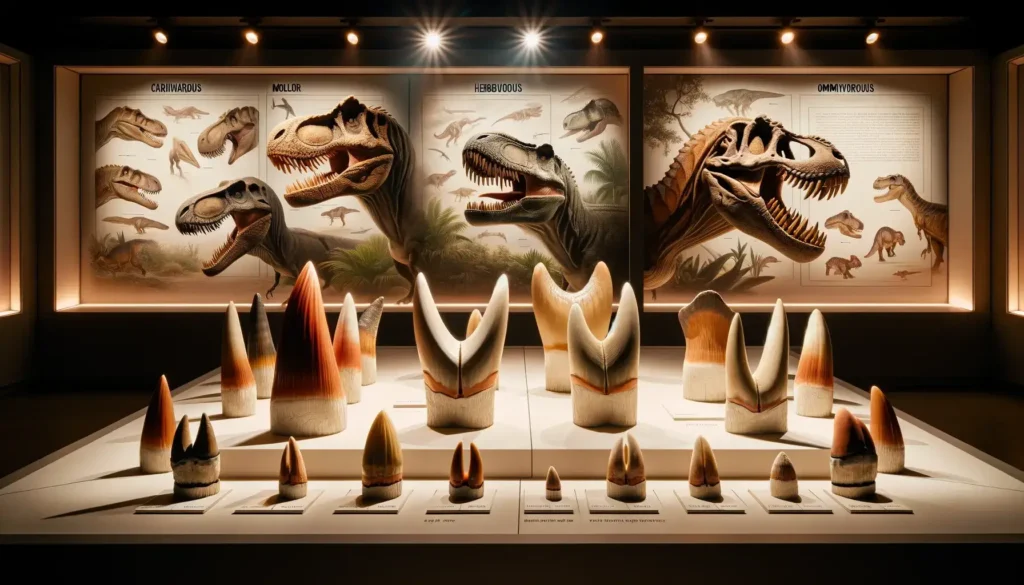
Why are Dinosaur Teeth Important?
The fossilized chompers of dinosaurs are not mere stones, but time capsules holding tales of an era long past. They are pivotal in piecing together the paleontological puzzle.
Paleontological Significance of Dinosaur Teeth
Dinosaur teeth hold a paramount position in paleontology. They are often among the most common fossils found, their hard enamel making them resistant to the ravages of time. These ancient dental records provide a snapshot into the life and times of dinosaurs, offering a tangible link to our planet’s astonishing prehistoric biodiversity.
- Species Identification: Often, teeth are key to identifying different dinosaur species. Their shapes, sizes, and arrangements in the jaws are like fingerprints, often unique to specific species.
- Age Estimation: The wear and replacement rates of dinosaur teeth can help estimate the age of the individual at the time of death, painting a picture of the dinosaur’s life cycle.
What Dinosaur Teeth Can Tell Us About Dinosaur Diet, Behavior, and Evolution
From a single tooth, much can be deciphered about a dinosaur’s diet, behavior, and evolutionary lineage:
- Dietary Habits: The morphology of dinosaur teeth is a direct reflection of their dietary habits. Sharp, pointed teeth indicate a carnivorous diet, while flat, broad teeth suggest herbivory.
- Behavioral Insights: Tooth marks on bones of prey reveal hunting and feeding behaviors, shedding light on the predator-prey dynamics of the prehistoric world.
- Evolutionary Pathways: The evolution of dental features over time showcases the adaptive strategies dinosaurs employed to survive in changing environments, charting the course of natural selection.
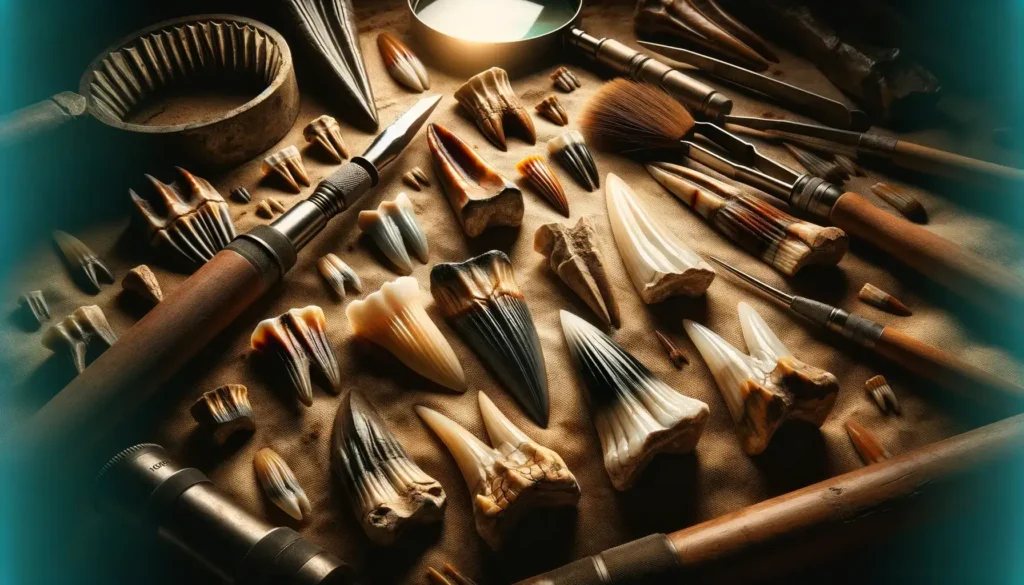
Different Types of Dinosaur Teeth
The diverse dietary habits of dinosaurs led to the evolution of a myriad of tooth forms, each tailored to a specific diet.
| Dinosaur Type | Tooth Characteristic | Example Dinosaur | Tooth Function |
|---|---|---|---|
| Herbivorous | Flat, Broad Teeth | Triceratops | Grinding leaves and branches |
| Dental Batteries | Hadrosaurs | Efficiently processing plant matter | |
| Carnivorous | Sharp, Serrated Teeth | Tyrannosaurus Rex | Tearing through flesh and bone |
| Strong Jaw Muscles | Allosaurus | Exerting tremendous force to subdue prey | |
| Omnivorous | Combination of Sharp & Flat | Oviraptor | Handling a varied diet of plants and meat |
| Specialized | Conical Teeth | Spinosaurus | Catching fish |
Herbivorous Teeth
Herbivorous dinosaurs, such as Triceratops and Brachiosaurus, had teeth designed to grind and crush tough plant material:
- Flat, Broad Teeth: Ideal for grinding leaves and branches.
- Dental Batteries: Some herbivores possessed dental batteries, complex arrangements of hundreds of teeth, to efficiently process plant matter.
Carnivorous Teeth
The predatory dinosaurs like Tyrannosaurus Rex and Velociraptors bore teeth that were instruments of death for their prey:
- Sharp, Serrated Teeth: Perfect for tearing through flesh and bone.
- Strong Jaw Muscles: Coupled with formidable teeth, their jaw muscles exerted tremendous force to subdue prey.
Omnivorous Teeth
Omnivorous dinosaurs such as Oviraptors had a mixed bag of dental features to handle a varied diet of plants and meat:
- Combination of Sharp and Flat Teeth: Allowing for both slicing and grinding.
Examples of Specific Dinosaur Teeth and Their Functions
- Tyrannosaurus Rex: Their teeth could be over 30 centimeters long (nearly 12 inches), designed for crushing bone and tearing flesh.
- Triceratops: Possessed rows of molars and pre-molars for grinding tough plant material.
- Spinosaurus: Had conical teeth for catching fish, a dietary adaptation unique among theropods.
Each dental adaptation not only showcases the dietary diversity among dinosaurs but also the intricate ecological web that existed in the Mesozoic Era, a testament to the wonder of natural evolution.
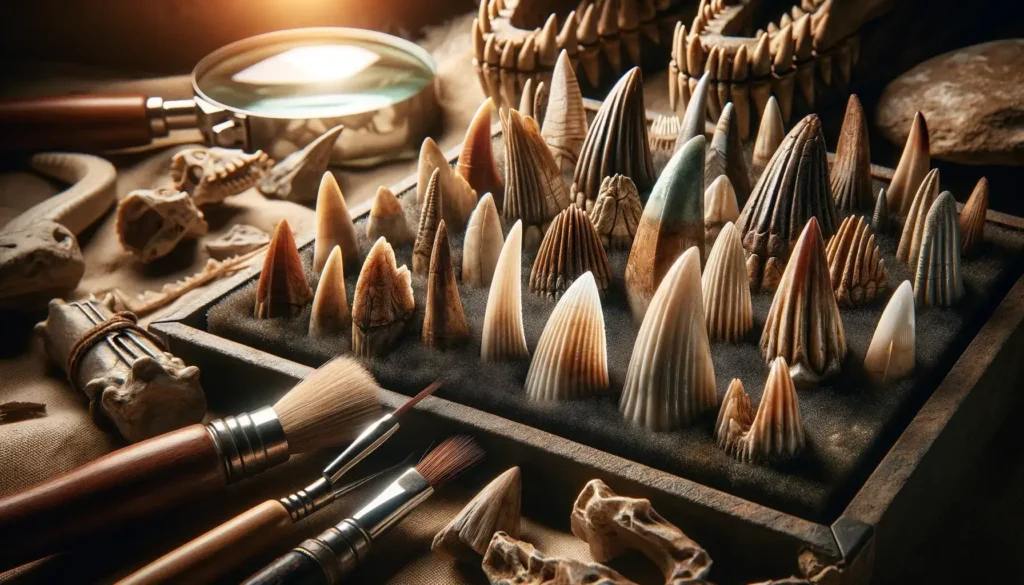
How to Identify Dinosaur Teeth
The realm of dinosaur teeth identification is as exciting as it is challenging. Armed with the right knowledge, you can differentiate between the teeth of herbivores, carnivores, and omnivores, each telling a story of a different lifestyle. Here’s a dive into the characteristics and tips for identifying dinosaur teeth.
Common Characteristics of Dinosaur Teeth
Dinosaur teeth, much like modern-day reptiles and mammals, have certain common characteristics:
- Enamel: The outermost layer, hard and glossy, ideal for protecting the tooth.
- Dentin: Underlying the enamel, dentin is a porous layer that provides the tooth its basic shape.
- Root: The part of the tooth embedded in the jawbone, crucial for anchoring the tooth in place.
These characteristics are foundational in beginning the identification journey.
Distinguishing Features of Different Types of Dinosaur Teeth
The fascinating part comes in when we start looking at the distinguishing features:
- Shape and Size: Carnivorous teeth are generally sharp and serrated, while herbivorous teeth are flat and grinding. The size of the teeth can also give clues to the size of the dinosaur.
- Serration: The presence and pattern of serrations on the edges of teeth are often specific to certain dinosaur species.
- Wear Patterns: Wear patterns on the teeth surfaces can indicate the type of food the dinosaur consumed.
| Feature | Carnivorous Teeth | Herbivorous Teeth | Omnivorous Teeth |
|---|---|---|---|
| Shape and Size | Sharp, serrated | Flat, broad | Mixed shapes |
| Serration | Present, often fine | Absent or coarse | Variable |
| Wear Patterns | Meat tearing marks | Grinding surfaces | Mixed wear patterns |
Tips for Identifying Dinosaur Teeth in the Field
If you find yourself lucky enough to come across dinosaur teeth in the field, here are some tips:
- Document the Location: The geographical location can provide significant clues as to what types of dinosaurs lived in that area.
- Compare with Known Specimens: Compare the teeth with known specimens from the area, or with images and descriptions in paleontological databases.
- Consult Experts: If in doubt, consult with paleontologists or join a local fossil group to learn from experienced individuals.
With patience and a keen eye, identifying dinosaur teeth can become an enriching experience linking you to a magnificent prehistoric world.
Conclusion
Our journey through the mystic world of dinosaur teeth has unveiled the secrets that lie within the jaws of these colossal creatures. From the intricacies of their dental anatomy, the paleontological significance, to the diverse types of teeth adapted to their varied diets, each tooth tells a story of survival, adaptation, and evolution.
The importance of dinosaur teeth in paleontology cannot be overstated. They are not merely ancient bones but a rich source of knowledge, offering a tangible link to understand the life and times of dinosaurs. The study and identification of dinosaur teeth is a field that blends excitement, education, and the thrill of discovery, offering endless possibilities for both the curious minds and the scholarly experts.
As we delve into these ancient dental relics, we are, tooth by tooth, unveiling the stories of a world gone by, yet so profoundly connected to our present understanding of life’s magnificent journey on Earth.

